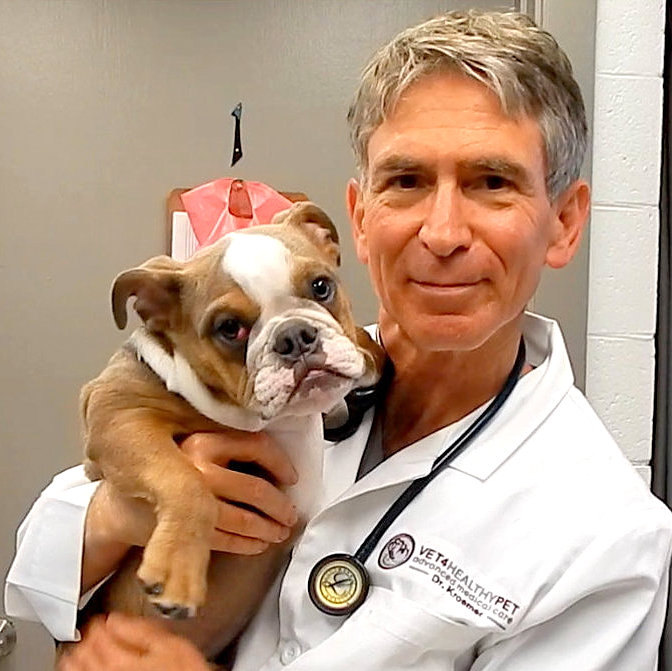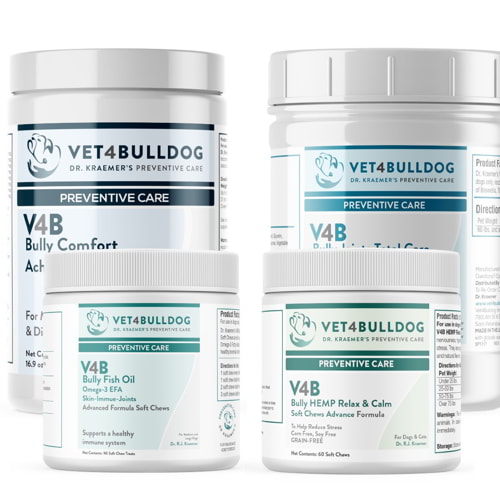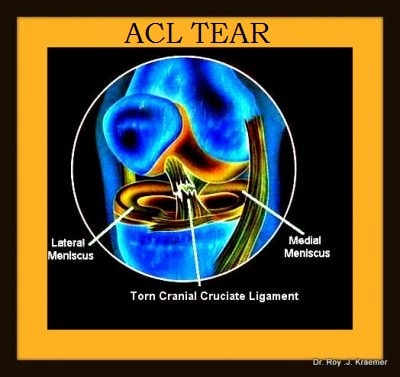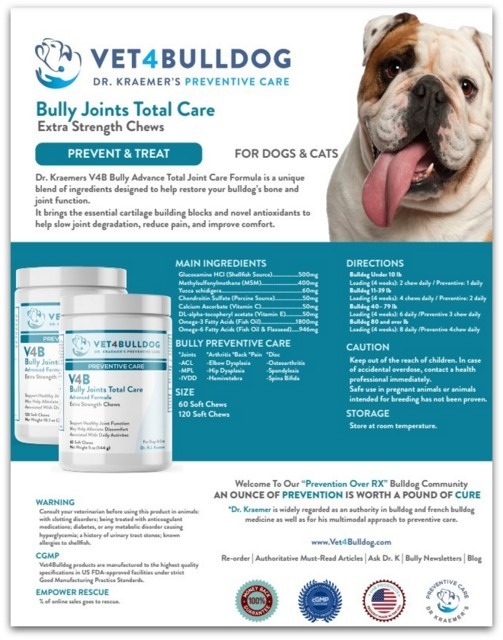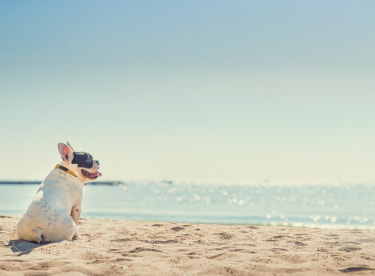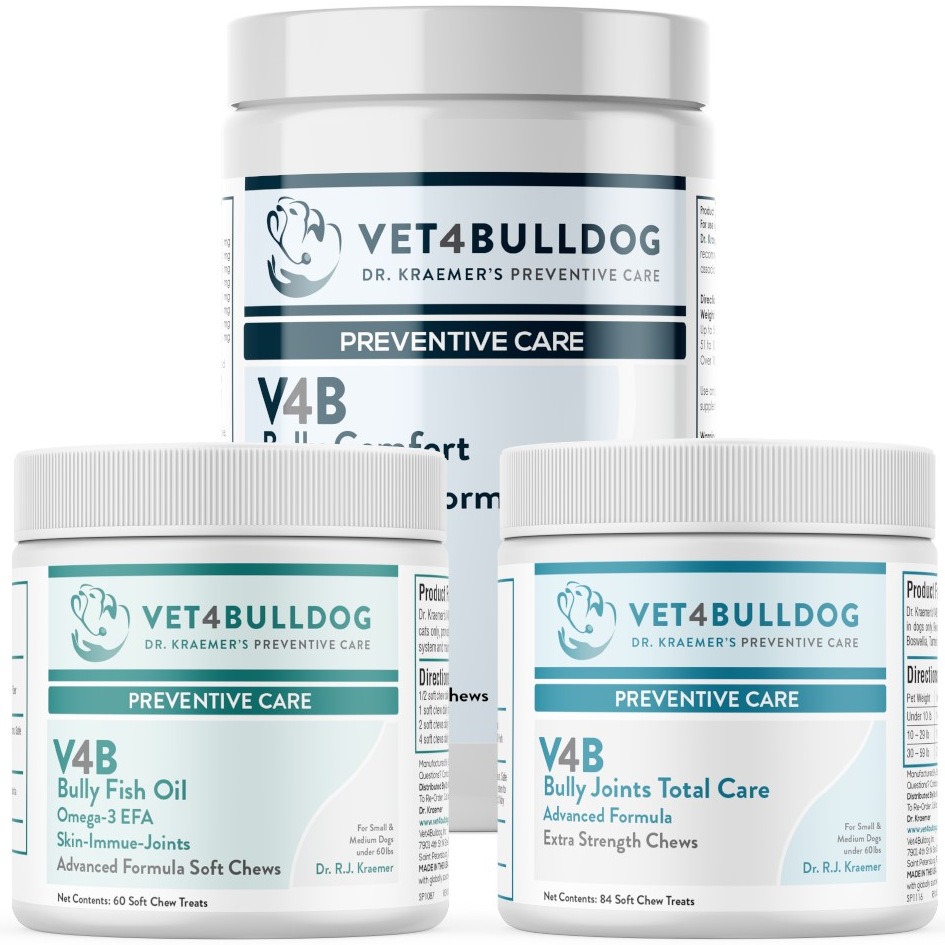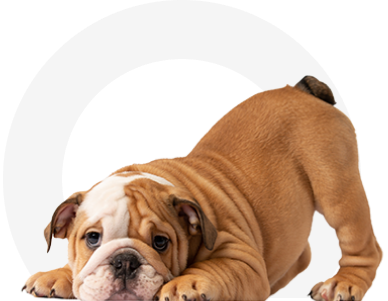“Hey Dr. Kraemer, 🆘🐶 I’m reaching out with a bit of worry about 3-year-old Rocky. Lately, I’ve noticed a change in his usual bouncy self. During playtime, he seems to favor his right hind leg, and there’s a noticeable limp. It’s heartbreaking to see him like this, especially since he’s usually very active and playful. I’ve read about ACL tears in dogs, and I’m concerned that might be the issue. Can you make recommendations? What should I do? 🐾❤️ #BulldogHealth #RockyTheTrooper”
ACL Tear Bulldogs French bulldogs are the most common orthopedic injuries I see in my bulldog practice.
Your bulldog’s knees are supported by four primary ligaments, which are as follows:
- MEDIAL COLLATERAL LIGAMENT
- LATERAL COLLATERAL LIGAMENT
- ANTERIOR CRUCIATE LIGAMENT (ACL)
- POSTERIOR CRUCIATE LIGAMENT
Bulldog ACL Injuries: 5 X MUST KNOW
- ACL injuries are one of the top orthopedic conditions in bulldogs and can happen at any age.
- The ACL is critical for stifle joint stabilization and normal biomechanics.
- TPLO is the gold standard for ACL surgical repair.
- Treatment includes weight control and pain management
- Prevention includes Dr. Kraemer’s Joint and Ligament Care Bundles
Members of this bulldog community prefer prevention over RX
ACL Tear in Bulldogs and French Bulldogs/FUNCTION:
The function of the ACL in bulldogs is threefold:
- TIBIAL THRUST: The first and most significant function is to prevent the forward thrust of the tibia
- INTERNAL ROTATION: Second, the ACL limits the internal rotation of the tibia.
- HYPEREXTENSION: Finally, the anterior cruciate ligament in bulldogs also prevents the hyperextension of the knee joint (stifle).
*Note: ACL (anterior cruciate ligament) is a human anatomical term, while CrCL (Cranial Cruciate Ligament) is the dog equivalent. In this article, I will use the terms interchangeably
ACL tear in Bulldog and French Bulldog puppies can happen as early as 6 months of age.
Bulldogs ACL vs. Human ACL
While canine and human knee anatomies are very similar, the biomechanics are very different
BULLDOG ACL BIOMECHANICS
When comparing the posture and biomechanics of humans and bulldogs, a clear difference emerges, particularly in how we bear weight. Humans typically stand with their heels on the ground and their knees relatively straight during weight-bearing activities. This upright stance aligns the body in a way that distributes weight and force vertically down through the hips, knees, and ankles.
In contrast, bulldogs (like many other four-legged animals) stand with their hocks (equivalent to human ankles) elevated and their knees bent while bearing weight. This difference in posture means that bulldogs experience different force vectors acting on their knees compared to humans. The bent knee position in dogs creates a more horizontal force vector, which affects the way stress and strain are distributed across the canine knee, specifically within the stifle joint (the equivalent of the human knee).
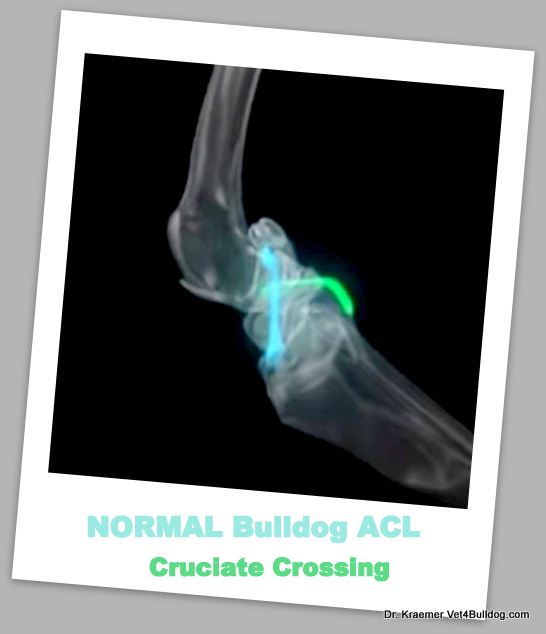
When the CCL is left as the primary defense against shearing forces without the support of strong leg muscles, it is subjected to increased stress and strain. Over time or with sudden, intense pressure, this can lead to injury to the ligament.
In the context of this “emergency brake” analogy, if the muscular “braking system” is not functioning optimally, the CCL is forced to handle excessive loads, making it prone to damage. This underscores the importance of maintaining strong and healthy leg muscles in bulldogs to support knee health and prevent injuries.
BULLDOG ACL-LOADED KNEE
Unlike humans, bulldog puppies are born with knees that have a natural degree of flexion, reflecting the typical stance of four-legged animals. This inherent flexion in the knee joint, combined with the natural sloping anatomy of the knee, results in a state where the anterior cruciate ligament (ACL) is consistently under tension or stress.
To illustrate this biomechanical concept, consider two parked cars: one situated on a flat street and the other on a steep slope.
CAR BREAK MODEL: HUMAN:
In the case of the car parked on the flat street, it remains stationary without any significant external forces acting upon it. Similarly, in humans, the ACL may experience periods of relative relaxation when the knee is not actively engaged in weight-bearing activities.
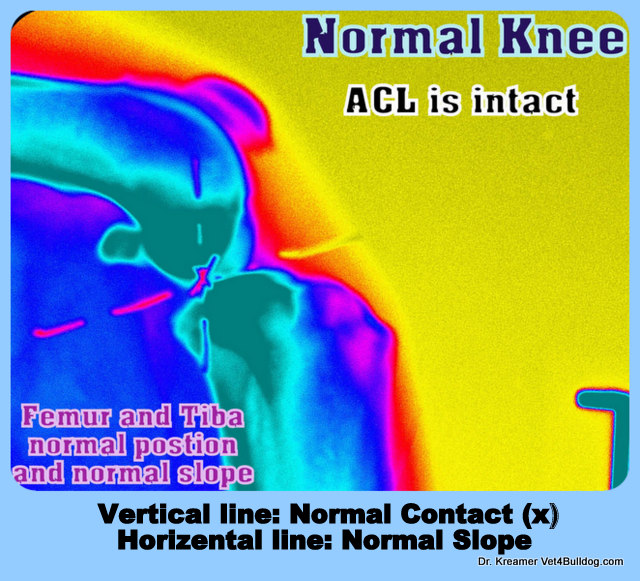
CAR BREAK MODEL: BULLDOG”
Conversely, the car parked on the steep slope faces a constant gravitational force pulling it downhill, placing stress on its brakes to prevent it from rolling. Similarly, in bulldog puppies, the flexed knee position and natural slope create a scenario where the ACL is continuously loaded or under tension, analogous to the brakes of the car on the slope.
This perpetual tension on the ACL reflects the inherent biomechanical demands placed on the knee joint in four-legged animals like bulldogs and underscores the unique considerations in understanding and managing knee health in this pet
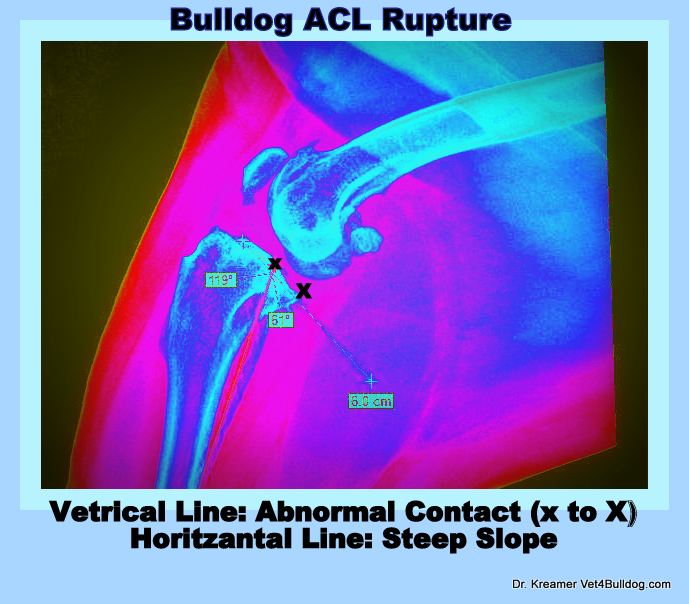
BULLDOG ACL CHRONIC STRESS
In humans, the tibial plateau typically exhibits a relatively level surface, characterized by a tibial plateau angle (TPA) of approximately four degrees.
This near-horizontal orientation of the tibial plateau means that most ACL tears in humans are traumatic and result from acute athletic injuries or sudden, forceful movements that place excessive stress on the ligament.
BULLDOG ACL STRESS & CHRONIC:
Unlike humans, who have a tibial plateau angle (TPA) of approximately four degrees, bulldogs exhibit a much steeper TPA, ranging from 25 to 30 degrees. This significant difference in TPA means that bulldogs have a more pronounced downward slope of the tibial plateau.
As a result of this steep slope, bulldog ACL injuries tend to be more commonly attributed to chronic biomechanical stress than acute traumatic events. The continuous downward force exerted on the ACL due to the sloped tibial plateau predisposes bulldogs to gradual wear and tear on the ligament over time
It is why in comparison with humans, bulldogs and bulldog puppies with untreated ACL tears usually do poorly.
BULLDOG ACL TIBIAL THRUST:
Due to the natural sloping of the tibial plateau in bulldogs, a force known as “Cranial Tibial Thrust” (commonly referred to as “draw,” although they are not identical) is present. This force propels the tibia forward, exerting pressure on the knee joint.
The role of the anterior cruciate ligament (ACL) is to counteract this forward motion of the tibia and the backward motion of the femur, thereby stabilizing the knee joint and preventing excessive movement.

A model of the knee slope (C), the ACL (F) and Menisci (E) . This model represents a Human knee
ACL Tear in Bulldogs and French Bulldogs/Presentation:
BULLDOG ACL TEAR PAIN & LIMP:
- TIBIAL RUB: Pain is inflicted when your bulldog’s femur rubs the tibia as it slides backward.
- MENISCUS INJURY: In addition to the challenges posed by the sloped tibial plateau and cranial tibial thrust, the presence of a meniscus injury can exacerbate pain and discomfort in bulldogs. The meniscus serves as a cushion between the femur and tibia, acting as a shock absorber to reduce friction and distribute forces within the knee joint. However, if the femoral bone slides abnormally due to the sloped anatomy, it can place stress on the meniscus, potentially causing injury or tearing. car.
Continuing with the analogy of the “BULLDOG CAR” facing uphill and the wooden block as a safety measure behind the back wheel, let’s imagine that the cable brake, representing the bulldog puppy’s ACL, suddenly snaps. As a result, all the weight of the car is suddenly transferred to the wooden block, symbolizing the bulldog puppy’s menisci.
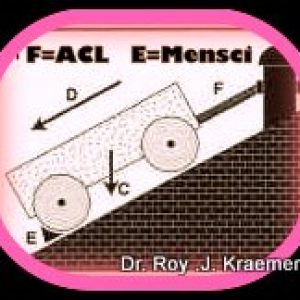
A model of the knee slope (C), the ACL (F) and Menisci (E) . This model represents a Bulldog (dog) knee
Meniscal tear is often accompanied by a “click” that can be heard when your bulldog walks.
50% of bulldogdogs with ACL injuries, will present with an injured menisci cartilage.
Bulldog ACL Injury/LIMP vs. TOE TOUCH:
In cases of ACL tears in bulldogs, a limp is often observed. However, when ACL tears are compounded by meniscal tears, the severity of the injury may lead to more pronounced symptoms. Bulldogs with ACL tears accompanied by meniscal tears may exhibit toe-touching behavior or may refuse to bear any weight on the injured leg altogether.
ACL Tear in Bulldogs/PREVENTIVE & MAINTENACE:
- Weight control
- Joint supplements
BULLDOG ACL INJURY WEIGHT CONTROL:
Maintaining your bulldog puppy’s fitness and ensuring they stay toned and lean is essential for promoting optimal musculoskeletal health and reducing the risk of ACL injuries. Inactive bulldogs are more likely to have weaker muscular support and poorer muscle function, which are crucial for stabilizing and “protecting” the ACL from excessive stress and strain.
Furthermore, bulldog obesity exacerbates the load placed on the knees, intensifying the daily wear and tear experienced by the ACL.
BULLY JOINT THERAPEUTICS
In addition to weight control, it also recommends that you keep your bulldog and French bulldog puppies on joint and pain control supplements like:
- Dr. Kraemer’s V4B Bully Total Joint for Advance Formula to help heal and replace the joint periarticular cartilage
- Dr. Kraemer’s V4B Bully Comfort Aid Formula helps manage pain and discomfort
- Dr. Kraemer’s V4B Bulldog Fish Oil Joint-Immune- Skin. to help reduce inflammation
- Dr. Kraemer’s V4B advanced HEMP Mobility
Drugs For Bulldog ACL Tear
- NSAIDs (non-steroidal anti-inflammatories)
- Analgesics: for pain
Dr. Kraemer’s ACL Rapture in Bulldogs RULE OF THUMB:
ACL SURGERY OUTCOME: post op outcome depends on owner compliance.
ACL Tear in Bulldogs and French Bulldogs SURGERY REPAIR:
Bulldog and French Bulldog ACL tear surgery goals are to stabilize the knee joint and do so early to minimize DJD (Degenerative Joint Disease, Bulldog Arthritis,).
Various repair methods have been employed, categorized into static repairs aiming to mimic the function of your bulldog’s ACL, and dynamic repairs which modify knee biomechanics to mitigate the necessity for a functioning ACL.

ACL Tear in Bulldogs: STATIC REPAIR:
Static repairs include
- intracapsular grafting techniques
- Extracapsular lateral suture techniques
- tight rope
- fibular head advancement

ACL Tear in Bulldogs/DYNAMIC REPAIR:
Dynamic repairs involve the neutralization of cranial tibial thrust (or cranial drawer) as the primary goal. The two current dynamic repair techniques addressing the underlying biomechanical instability in a canine ACL tear are the
- Tibial plateau leveling osteotomy (TPLO)
- Tibial tuberosity advancement (TTA).
The TPLO which changes the angle of the tibial plateau, has been popular for over a decade and is considered the gold standard for bulldogs.
The TTA is a technique that changes the relationship between the patellar tendon and the tibial plateau angle via an osteotomy (bone cut).
SURGEON EXPERIENCE TIP:
First, you should know that not just any veterinarian can perform either of these procedures. To truly master these surgical techniques, extensive training is required.
PREFERED TECHNIQUE TIP:
Even within the veterinary profession, there remains ongoing debate regarding the most optimal surgical procedure for ACL repair in bulldogs. Different veterinary surgeons may advocate for varying techniques, leading to diverse opinions and preferences. It’s common for surgeons to favor a particular method based on their training, experience, and personal biases.
However, it’s important to recognize that both static and dynamic repair methods can be effective when performed by skilled and experienced surgeons. Ultimately, the success of the surgery often depends more on the surgeon’s proficiency and expertise in executing their chosen technique with precision than on the specific method itself.
TPLO (Tibia Plato Leveling Osteotomy) is my preferred surgical choice for ACL tears in bulldogs and is considered the gold standard by most orthopedic surgeons.
Dr. Kraemer’s ACL Tear in Bulldogs STEM CELL THERAPY
For many of our ACL-injured patients, we combine regenerative medicine with traditional medicine and surgery
STEM CELL THERAPY & CRYOBANING:
stem cell therapy is a state-of-the-art treatment that we often combine with surgery.. In addition, other joints and medical conditions can be treated simultaneously. Last, as an additional benefit, we almost always cryobank some pet stem cells for future medical and surgical needs.
I’m frequently asked about the effectiveness of stem cell therapy as a noninvasive alternative to ACL tear surgery repair. Generally, I advise against it as it doesn’t address the underlying biomechanical issues. However, I often recommend and perform stem cell therapy in conjunction with surgery to enhance healing, improve range of motion, and mitigate osteoarthritis. This combined approach also aims to prevent future ACL tears in the opposite knee.

Furthermore, we typically preserve some of our clients’ stem cells through cryobanking for potential future medical and surgical needs. It’s worth noting that many reputable pet insurance companies now cover stem cell therapy for pets, offering an additional option for financial support in these cases.
It is my experience that about 50% of bulldogs will have the other knee torn within one year.
In contrast to surgery, stem cell therapy can provide pain relief for multiple injuries at once with minimal anesthesia, and minimal post-surgery downtime, all at a relatively low cost. Plus, the stem cells can be cryobanked for additional future treatments
There are situations where non-surgical treatment with stem cell therapy alone may be appropriate for dogs with ACL tears. In cases where surgery is not feasible or preferred by the owner due to factors like
- advanced age
- anesthesia risks
- cost
- prolonged post-op confinement
- extended recovery time
Additionally, for dogs with multiple orthopedic issues alongside the ACL tear, such as
- elbow dyspepsia
- hip problems
- arthritic hocks
In cases where surgical repair of only one problem may not be the most effective approach, stem cell therapy can offer pain relief for multiple injuries simultaneously. This treatment option comes with the benefits of minimal anesthesia and post-surgery downtime, along with a relatively low cost.
Moreover, stem cell therapy provides the advantage of cryobanking, enabling the preservation of stem cells for potential future treatments. This flexibility and versatility make stem cell therapy an appealing option for certain situations where surgery may not be the optimal solution
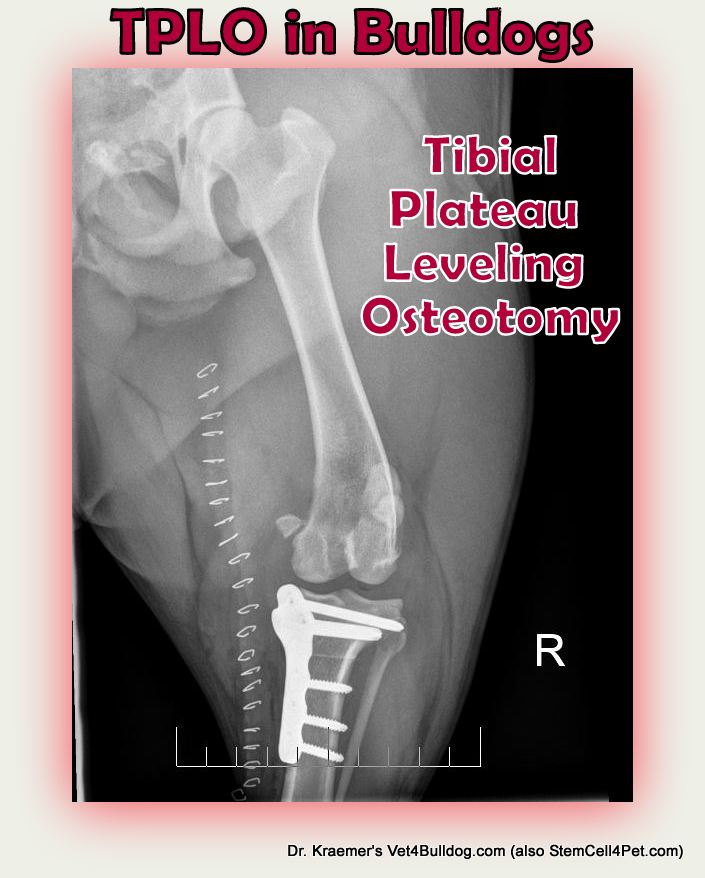
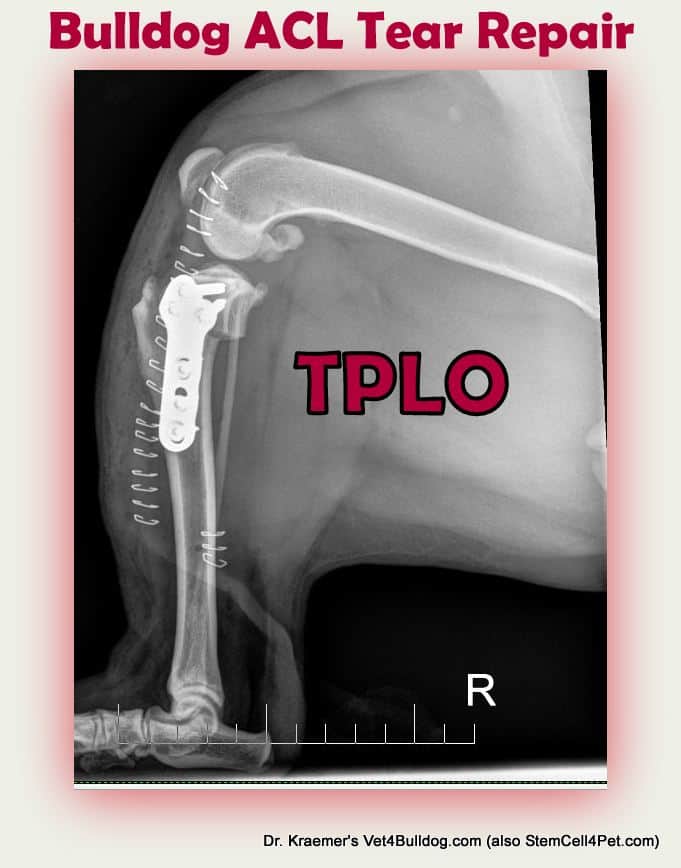
Bulldog and French Bulldog ACL Tear TPLO REPAIR
The philosophy behind TPLO (Tibial Plato Leveling Osteotomy) surgery is to completely change the dynamics of the dog’s knee so that the torn ligament becomes irrelevant to the knee’s stability.
TPLO repair is our preferred surgical repair method.
The TPLO completely alters the dynamics of the knee by neutralizing the effect of the forward tibial thrust. Once the tibia is cut and rotated, the femur can no longer slide backward, and the knee is immediately stabilized.
Menisci injuries in bulldogs are also corrected during the surgery.
BULLDOG TPLO SURGEON
Choosing between TPLO and TTA depends on the degree of the tibial sloop, the tibial plateau, and the health of the patella and patella ligament. The dog’s general anatomy, degree of osteoarthritis, and age should all be taken into account.
But most important is the surgeon’s experience with the elected procedure.
TPLO SURGERY COST
The cost of TPLO surgery in dogs varies depending on the region and who is performing the surgery.

TPLO vs. STATIC REPAIR
The bulldog puppy’s tibial slope and resulting sliding action are why most orthopedic veterinary surgeons have abandoned old-style static replacement procedures in favor of dynamic ones like TPLO and TTA. Again, this is in sharp contrast to human orthopedics, where replacement with a biological graft is the standard.
ACL Tear in Bulldogs TIPS & WARNINGS:
Below are selected ACL injury tips & warnings, courtesy of Dr. Kraemer
ACL RADIOGRAPH TIP:
Radiographs are very helpful in diagnosing bulldogs’ ACL tears and ruptures. In some instances, the radiograph will catch the joint in this slipped or drawn position. Other common radiographic findings are joint effusion (fluid) and evidence of osteoarthritis.
BULLDOG ACL RAPTURE TIP
In my practice, the typical presentation of an ACL injury involves a bulldog that is experiencing sudden hind limb lameness, which may improve initially with pain management medication and rest.
However, there’s often a subsequent worsening of lameness, indicating a potential re-injury or full rupture of the ACL. This pattern suggests that the dog may have initially suffered a partial tear that temporarily improved with rest but ultimately led to further injury.
ACL INJURY AND HYPEREXTENSION TEST TIP
The majority of bulldogs with an ACL rupture or partial tear exhibit pain when the tibial thrust maneuver is performed or when the stifle joint is placed in hyperextension. These actions exacerbate discomfort and are indicative of instability and potential damage to the ACL.
BULLDOG ACL TIBIAL NOTCH TIP:
It is my conclusion that the bulldog’s knee’s tibial femoral space is different than that of other breeds. This finding has been confirmed by my orthopedic surgeon, Dr. Paul Cechner, Diplomate A.C.V.S. who has been operating on a dog’s knees for over 40 years and on my bulldog patient’s knees for a decade.
We’ve noticed a narrowing of the tibial femoral space (notch) in bulldogs, particularly on the inner part of the joint where the ACL attaches. This reduced space leaves minimal room for the ligament to move, potentially increasing the risk of wear and tear and raising the likelihood of rupture or partial tears in the ACL.
BULLDOG ACL MEDIAL BUTTRESS TIP:
Some bulldogs form a bump on the inner aspect of their knee, which is a fibrotic response to stifle instability.
BULLDOG ACL PAIN & LAMENESS TIP
Pain and lameness associated with bulldog ACL injuries stem from the instability of the stifle joint and the resulting inflammation. When the ACL is torn, the stretching of the joint capsule sets off a chain reaction of events.
This includes cartilage degradation and the development of degenerative joint disease, collectively contributing to the discomfort and impaired mobility experienced by the bulldog.
BULLDOG MENISCUS TIP:
Frequently, the pain experienced by your bulldog intensifies when the medial meniscus is compressed beneath the medial femoral condyle. This occurs as a result of the forward movement of the tibia and the backward sliding of the femur during cranial tibial thrust.
BULLDOG ACL TEAR TESTING TIP:
Bulldogs and other dogs with a CrCL injury and subtle lameness may display characteristic signs in their gait and posture. You may notice a shortened stride and a slightly extended stifle on the affected limb. Conversely, the normal limb may appear to bear more weight and land harder on the ground.
Observing how the dog sits can also provide valuable clues. Dogs with a CrCL injury may sit with the affected leg extended and positioned outward to the side. This specific sitting posture is referred to as the “positive seat test” and can indicate discomfort or instability in the knee jo
BULLDOG ACL INNER ROTATION TIP:
In addition to its role in forward thrust, the ACL in bulldogs also functions to prevent the inner rotation of the tibia. This rotational constraint is particularly crucial given the unique anatomical characteristics of bulldogs, which predispose them to ACL tears.
BULLDOG ACL RAPTURE TIBIAL LOAD TIP:
Nearly all bulldogs exhibit some degree of hip dyspepsia and/or medial patella luxation, both of which impact the function of various muscle groups in the hind limbs.
These conditions affect muscles such as the quadriceps, gastrocnemius (calf), and hamstrings, causing them to shorten and contract. Consequently, this muscular imbalance further exacerbates the inward load on the tibia, contributing to the predisposition for ACL tears in bulldogs
ACL TEAR PRP TIP:
In addition to stem cell therapy, many of my patients, including dogs and cats undergoing orthopedic surgical procedures, also receive PRP (Platelet Rich Plasma) during surgery. This involves the direct injection of PRP into their joints. When administered alongside a surgical procedure, the cost is minimal, and the benefits are well-documented, both for pets and
ACL STRESS INJURY TIP:
A bulldog puppy suffering from an ACL injury might have just a subtle limp that turned into a sudden acute non-weight-bearing lameness.
However, unlike humans, the injury is rarely of a purely traumatic etiology.
BULLDOG ACL PARTIAL TEAR TIP
Partial ACL tears in bulldog puppies are not uncommon, and only one portion of the ligament can experience a complete tear. Because ACL injuries tend to be degenerative, a considerable number of bulldogs with partial tears will eventually progress to a full tear of the ligament
ACL LASER THERAPY TIP
All my orthopedic surgeries, including Bulldog ACL tears, are treated post-op with class 4 cold laser therapy to reduce pain and enhance healing.
ACL tPEMT TIP
All our bulldog ACL surgeries and other orthopedic surgeries are sent home post-op with pain management medication (NASID and other analgesics). In many cases, we also send our post-op surgical cases, such as the Bulldog TPLO for ACL tear with PEMT loop, a safe device that enhances healing, reduces inflammation, and improves pain control.

BULLDOG ACL OSTEOARTHRITIS WARNING
When left untreated, ACL injuries in dogs invariably result in progressive osteoarthritis, which is a lifelong, debilitating, and chronically painful condition.
Additionally, untreated ACL injuries often cause uneven weight-bearing, leading to overcompensation by other legs and joints. This overcompensation places increased stress on the contralateral knee, raising the likelihood of additional injuries and potentially resulting in an ACL tear on the opposite knee.
ACL TEAR BRACES WARNING:
The anatomy and biomechanics of the bulldog and French bulldog stifle differ significantly from those of humans, leading to misconceptions among pet owners. Non-surgical treatments for bulldog ACL tears are often ineffective due to the chronic biomechanical stress unique to these breeds.
The specific tibial plateau slope and joint biomechanics of bulldogs make braces relatively ineffective for managing ACL tears in these dogs.
ACL LIMPING WARNING
Bulldog CrCL (Cranial Cruciate Ligament) injuries should be considered and investigated in cases of hind-limb lameness. Affected dogs may present with various degrees of lameness, likely due to the multifaceted nature of the condition.
Your bulldog puppy may exhibit non-weight-bearing, partial weight-bearing, or occasionally non-ambulatory behavior as a result of this injury.
ACL HYPEREXTENSION WARNING
Some bulldogs may display mild and chronic lameness, indicating a partial CrCL (Cranial Cruciate Ligament) rupture. In these cases, there may be minimal joint swelling (effusion), and radiographs may not show signs of osteoarthritis. While these dogs may not exhibit the cranial drawer sign, they will likely experience discomfort and pain during the tibial thrust maneuver.
This discomfort is often caused by the compression of the inner menisci when the stifle joint is placed in hyperextension.
ACL OTHER PROBLEMS WARNING:
Less commonly, some bulldogs may present with acute non-ambulatory symptoms, such as difficulty rising or shifting leg lameness. Unfortunately, these cases are occasionally misdiagnosed as neurological conditions like disc disease, or bulldog malformation. Adding to the complexity, these patients may also have concurrent conditions such as hip dysplasia, degenerative joint disease (DJD), and lumbosacral disease.
Distinguishing between a CrCL tear and bulldog back disease requires a thorough orthopedic and neurological examination to accurately diagnose the underlying issue.
ACL RADIOGRAPH WARNING:
When examining a French Bulldog for potential ACL injuries, it’s crucial to assess both legs and conduct radiographs, as the opposite side may also be affected due to compensatory mechanisms. To ease the examination process, I typically start with the “good” leg, allowing the bulldog to relax and establish baseline responses
A palpable or audible click may indicate a meniscal tear.
ACL TEAR DRAW SIGN WARNING:
If a cranial drawer sign is not palpated in a bulldog suspected of having a CrCL injury, it’s important to consider re-evaluating the cranial drawer under sedation. This step is necessary because the bulldog may be resisting palpation due to muscle tension or significant fibrosis that has stabilized the stifle joint. Additionally, the absence of a drawer sign in a bulldog’s knee could be attributed to a partial ligament tear, with the remaining intact ligament resisting gross displacement.
Sedation allows for a more accurate assessment by relaxing the muscles and minimizing resistance during the examination.
ACL AND MPL WARNING:
Many bulldogs experience MPL(medial/inner patella taxation) either before or alongside ACL injuries. These two conditions can be interconnected because patients with MPL often exhibit medial rotation of the tibial crest. This rotation places continuous tension on the ACL, which is believed to predispose bulldogs to ACL tearing. Therefore, the presence of MPL can contribute to the development or exacerbation of ACL injuries in bulldogs.
Additionally, bulldog puppies diagnosed with MPL may experience persistent osteoarthritis in their stifles. This ongoing condition can create an enzymatic environment that contributes to the deterioration of the ACL over time.

Moreover, the rupture of the ACL tends to worsen the severity of patellar luxation. This is primarily because the loss of constraint on the inward rotation of the tibia and the cranial displacement of the tibia during weight-bearing exacerbate the condition. Consequently, this movement alters the insertion point of the patellar tendon, causing the patella to be “lifted” out of the trochlear groove and facilitating luxation
ACUTE BILATERAL ACL RAPTURE WARNING
Acute bilateral ACL ruptures (i.e., both ACL tears at once) are rare, but when present, they are erroneously diagnosed as a neurological condition, such as degenerative myelopathy or herniation of an intervertebral disc. A bulldog with acute bilateral ACL rapture will have great difficulty rising and may appear to have hind limb paresis.
BULLDOG ACL STEROIDS WARNING:
I don’t recommend treating bulldog ACL injuries with long-term cortisone (prednisone) due to the steroid effects on cartilage and healing, as well as other adverse effects it’s known for.
Recommended by Owenrs Approved by Bulldogs



